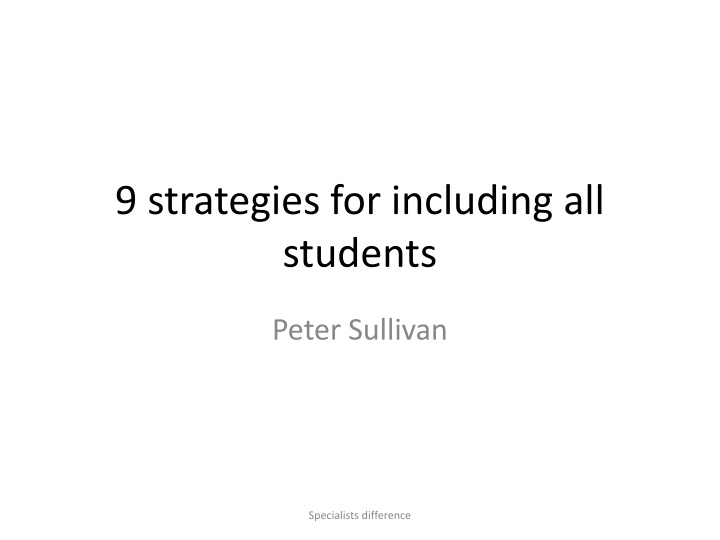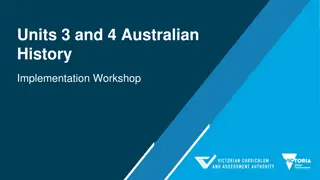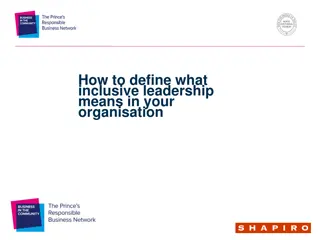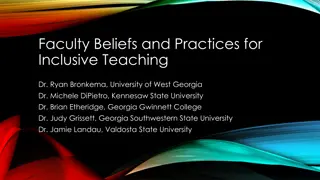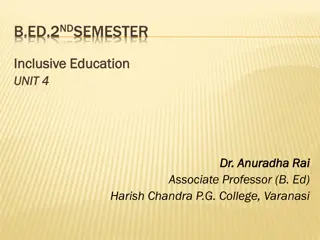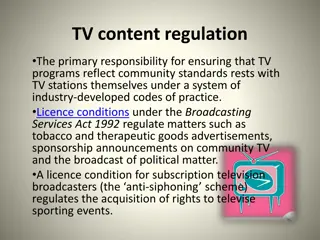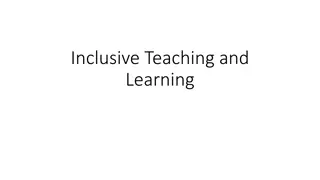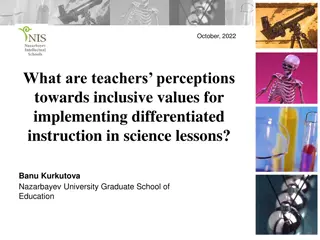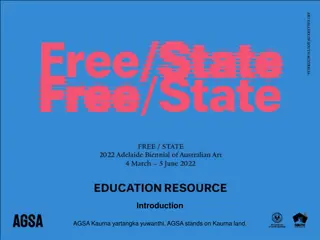Strategies for Inclusive Teaching in Australian Schools
The Australian school context reflects challenges in teaching mathematics, with dissatisfaction over traditional methods. This content explores strategies for including all students, addressing classroom difficulties for low and high achieving students. Teacher anxiety plays a crucial role in lesson planning.
Download Presentation

Please find below an Image/Link to download the presentation.
The content on the website is provided AS IS for your information and personal use only. It may not be sold, licensed, or shared on other websites without obtaining consent from the author.If you encounter any issues during the download, it is possible that the publisher has removed the file from their server.
You are allowed to download the files provided on this website for personal or commercial use, subject to the condition that they are used lawfully. All files are the property of their respective owners.
The content on the website is provided AS IS for your information and personal use only. It may not be sold, licensed, or shared on other websites without obtaining consent from the author.
E N D
Presentation Transcript
9 strategies for including all students Peter Sullivan Specialists difference
Overview Some contextual information 9 approaches That can be used individually or in combination For whatever is the content or level or source (Maths 300, resolve, etc) even though a particular example is given to illustrate Which can be used by you when leading teacher professional learning Specialists difference
The Australian school context The long tail Widespread dissatisfaction (from teachers, students and parents) with the way mathematics is taught Emphasis on telling followed by practice Overuse of texts designed for practice rather than learning (and certainly not for fostering creativity and student decision making) Disconnect from meaning and relevance Belief by teachers (and parents and students) that some (many?) cannot learn mathematics Specialists difference
Of course, it is difficult to include everyone when there are fast learners in the class who shout answers and criticise others who are still thinking through problems that the fast learners have already solved, and who complain to their parents about being under-extended some others who have more or less given up believing that they cannot learn, and who prefer to interrupt others extensive and exhaustive lists of content to cover that pressure teachers to skim from topic to topic routines in schools that leave teachers with limited time for collaboration, sharing ideas, innovating, Specialists difference
What makes classroom learning difficult for low achieving students? Specialists difference
What classroom organisational factors might restrict opportunities for high achieving students? Specialists difference
My impression is that teacher anxiety about how low achieving students will respond has a much stronger influence on planning than worry about the high achieving students Specialists difference
What score describes the majority of teachers in your school? 1 = They always want students to answer many questions using the methods the teachers have told them to use 10 = They always pose only a few questions which students answer using intuitive methods discussing their strategies explaining their reasoning Specialists difference
What score describes the majority of teachers in your school? 1 = They always have a teaching group, usually of low achieving students, and the teachers explain what the students are expected to do and how they should answer the questions 10 = They never have a teaching group of low achieving students while the other students are working. They teachers expect all students to work out what to do for themselves. Specialists difference
What score describes the majority of teachers in your school? 1 = They always give low achieving students tasks at which they are likely to be successful even if the tasks are much much easier and quite different from what the bulk of the class are doing and if the students are stuck they tell them how to do it 10 = They always expect low achieving students to participate in the same experiences as the class even if at a different level of expectation, giving alternate prompts and the occasional nudge but minimising telling or rescuing Specialists difference
Including all students Classrooms are also social settings ... and no one wants feel limited in front of their peers Some respond with what is described as performance avoidance There are long term risks with achievement groupings (more so if the Maggots are given experiences that are not age appropriate or a limited curriculum) Specialists difference
You have heard about the importance of evidence Stratification, streaming, tracking, setting has minimal effect on learning outcomes and profound negative equity effects. (Hattie, 2009, p. 90) Specialists difference
Some fundamental principles All can learn Effort increases ability as well as achievement We do not learn by listening and teachers do not foster creativity, insight, etc by telling Much learning is social, so experiences in which the whole class participates contribute to building a class community Specialists difference
Common to all 9 strategies Suitable for whole class mixed achievement teaching Student centred (experience before instruction note that if students are expected to do tasks OUR way, this increases their sense of risk) Expectation of student thinking and decision making (open-ended or open middled) Specialists difference
Of course we do not want to exacerbate anxiety, but which of these two approaches is likely to result in students feeling a sense of failure and which ends with them feeling they have learned? Teach first, moving from simple to complex Struggle first, moving from complexity to clarity Specialists difference
Memory is the residue of thought From Daniel Willingham, professor of psychology at the University of Virginia. Students remember what they have been thinking about, so if you make the learning too easy, students don t have to work hard to make sense of what they are learning and, as a result, forget it quickly. Specialists difference
and high level student thinking is connected to student learning National Council of Teachers of Mathematics (NCTM) (2014) noted: Student learning is greatest in classrooms where the tasks consistently encourage high- level student thinking and reasoning and least in classrooms where the tasks are routinely procedural in nature. (p. 17) Specialists difference
What these approaches are NOT!! Asking questions that are so easy that everyone can do them with minimal effort Setting up collaborative groups that allow some students to hide Excessive practice of what is already known Complex contextualised even interesting tasks that are time consuming but with limited maths (planning a party) Specialists difference
The examples are from year 1 place value The focus is on the patterns (such as in the 100s chart) And answering questions like 10 more, 10 less, without counting on or using fingers etc The year 1 AC includes: Recognise, model, read, write and order numbers to at least 100. (ACMNA013 - Scootle ) Count collections to 100 by partitioning numbers using place value (ACMNA014 - Scootle ) Specialists difference
Strategy 1 Create experience Create your own experience activities on which subsequent tasks/lessons might build Specialists difference
Rationale What we know is a product of our experience Some students have preliminary experiences at home, with family, in the community (and others do not) Offering an practical experience that is preliminary to an intellectual experience helps to give all (more?) students access Specialists difference
Creating experience Specialists difference
At your table, get into two groups with a different number of people in each group What is an equation that describes what you have done? Can you do it a different way? Specialists difference
Strategy 2 Pose tasks with a low floor high ceiling Ask questions with multiple entry points and multiple exit points Such questions will often be open-ended Specialists difference
Rationale The idea is that many students will be able to give at least one possible (correct) response While others might give many (perhaps also seeing, unprompted, patterns and abstractions) All can feel part of the community and that they are progressing Specialists difference
Missing numbers on the jigsaw piece What might be the numbers on the L Shaped piece? I know that one of the numbers is 65. Give as many possibilities as you can. (You can rotate but not flip) Specialists difference
What is the floor and ceiling of this task? Three students between them have They each have different amounts of money How much might they each have? Specialists difference
Strategy 3 Enabling and extending prompts Enabling and extending prompts are variations on the original task but still have students working on the same page These apply to any type of task (not just open- ended ones) Specialists difference
Rationale Enabling prompts involve slightly varying an aspect of the task demand, so that a student experiencing difficulty, if successful, can proceed with the original task. This approach is quite different from the more common requirement that such students listen to additional explanations; or pursue goals substantially different from the rest of the class. Specialists difference
Creating enabling prompts Propose a change to the representation Simplify the numbers Pose a similar problem with fewer variables Pose a similar problem with fewer steps Specialists difference
An illustrative enabling prompt What might be the missing numbers on this piece? Specialists difference
What might be an enabling prompt for this task? Three students between them have They each have different amounts of money How much might they each have? Specialists difference
Extending prompts for those who have finished Extension is best if it encourages depth and abstraction and generalisation It is helpful to include the faster finishers in the class discussions The key is arousal Specialists difference
Creating your own extending prompts Change the representation Make the numbers more complex Change the number of steps Convince me What if the numbers were different .. Create your own Specialists difference
Illustrative extending prompt(s) Convince me that you have all of the possible combinations. If the jigsaw piece had 5 squares, how many possibilities would there be? Specialists difference
What might be an extending prompt for this task? Three students between them have They each have different amounts of money How much might they each have? Specialists difference
Strategy 4 Pose consolidating tasks Consolidating tasks are a bit the same and a bit different from the original task Specialists difference
Note that this is arguably the most important and we focus on this further on Friday Specialists difference
Rationale Students struggle with the first task, listen to strategies for solving, then move to a similar task on which those new strategies can be applied There is no expectation that all students can do the first one(s), but more can do the subsequent one(s) Specialists difference
The following slides are some examples of consolidation Which ones do you think consolidate the learning from the first task (the patterns in the 100s chart)? Specialists difference
Letters of the alphabet The numbers 62 and 84 are on the same jigsaw piece The piece is shaped like a letter of the alphabet Draw what that piece might look like and write in the numbers Give two different possibilities Specialists difference
Spot the mistake Find the mistakes in this hundreds chart. Explain how you found them. 1 11 21 31 41 51 61 71 81 91 101 2 12 22 32 42 52 62 72 82 92 102 3 13 23 33 33 53 63 73 83 93 103 4 13 24 34 44 54 64 74 84 94 104 5 15 25 35 55 55 65 75 85 95 105 6 16 16 36 46 56 66 76 96 96 106 7 17 27 37 47 57 67 77 87 97 107 8 18 28 38 48 48 68 78 88 98 108 9 19 29 39 49 59 69 79 89 99 109 10 20 30 40 50 60 70 80 90 100 200 Specialists difference
Which are possible? Which of the following jigsaw pieces could be from our jigsaw, and which are not? Explain your reasoning. Specialists difference
What might be consolidating suggestions for this task? Three students between them have They each have different amounts of money How much might they each have? Specialists difference
Strategy 5 Inclusive fluency experiences Specialists difference
Rationale Too often, fluency games and activities have the effect of helping the students that are already fluent Inclusive experiences engage all students in multiple calculations in a short time There are advantages in group and class chorusing (even if some are only listening) It helps if the fluency practice connects with the lesson and the lesson helps to reinforce the particular skill Specialists difference
